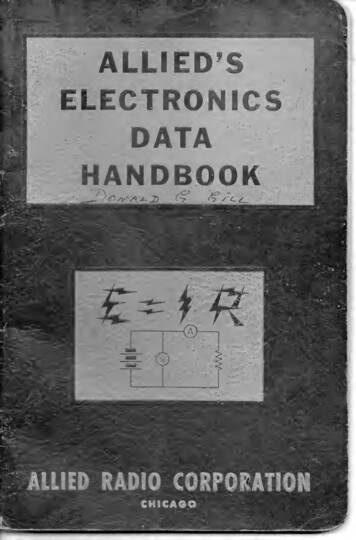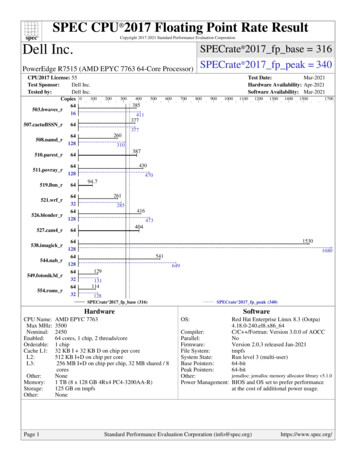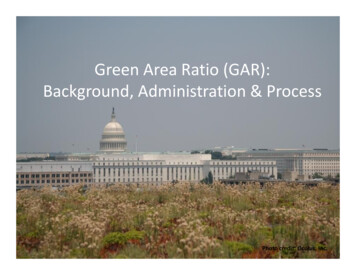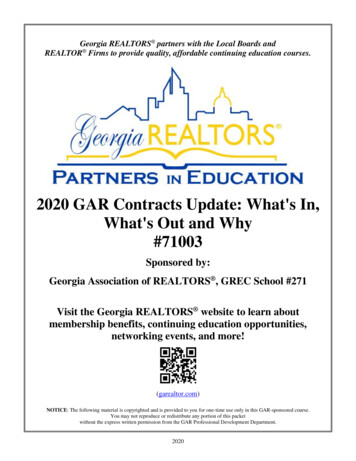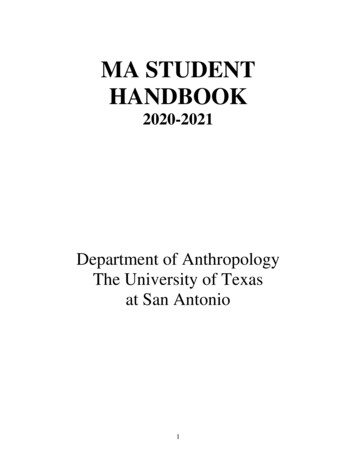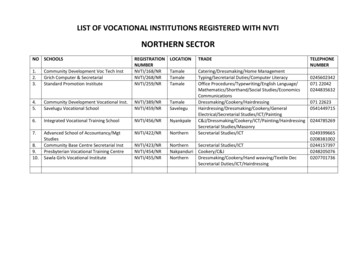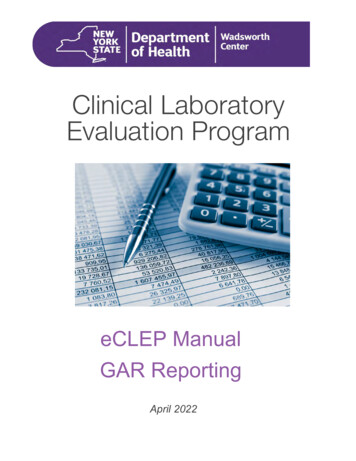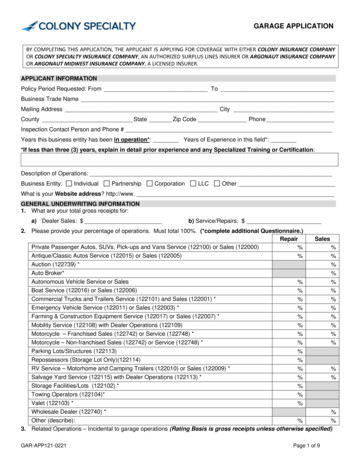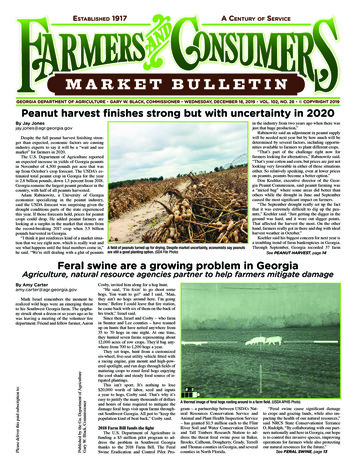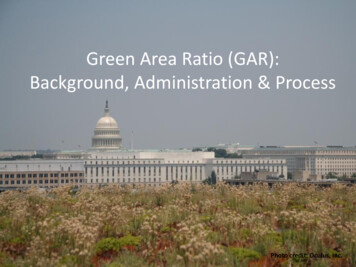
Transcription
Green Area Ratio (GAR):Background, Administration & ProcessPhoto credit: Oculus, Inc.
AGENDA Zoning Regulations Review Green Area Ratio Regulation Regulatory Triggers Administrative Considerations Related Regulations (Pervious Surface/Parking Lots) Landscape Elements
Zoning Regulations Review Revision to zoning regulation passed January 2016Improve clarity, ease of use, relevanceDiagnosis of barriers to sustainability policy areaZoning Commission weighed in on recommendationson .––––––Integrating Land Use and MobilityEnergy Conservation and Renewable EnergyWater and Sensitive Resource ProtectionFood SecurityGreen JobsLarge Area Development
ZRR and changes to GAR Zoning Regulations Review passed January 2016 GAR regulation revisions will be effective September 6,2016 For additional information on transition:http://dcoz.dc.gov
Green Area RatioWhat is it?Examples may include A flexible green site designrequirement that varies byzone.How Achieve? Choose from a range ofenvironmental landscapepractices each of whichhave been assigned anenvironmental performanceranking. Permeable pavementGreen roofsNatural ground coverRain gardensTrees & shrubsGreen facades
Seattle Green FactorStated Priorities: Livability Ecosystem Services Climate ChangeAdaptation“Emphasizing landscape in site planning. Earlierinvolvement in the design process allows landscapearchitects to exercise more creativity and developinnovative design solutions.”
GAR: How Does it Work?How to calculate: Add up landscape elements bynumber or size–––––# treesSize of green roofSize of rain garden# of plantsSoil depths Divide by lot area GAR score
GAR LANDSCAPE ELEMENTSLandscaped area (select one of the following for each area)Landscaped areas with a soil depth of less than 24”Landscaped areas with a soil depth of 24” or moreBioretention facilitiesPlantingsGround covers, or other plants less than 2’ tall at maturityPlants at least 2’ tall at maturityTree canopy for all new trees with mature canopy spread of 40’ or lessTree canopy for all new trees with mature canopy spread of 40’ or greaterTree canopy for preservation of existing trees 6” to 24” in diameterTree canopy for preservation of existing trees 24” diameter or largerVegetated wall, plantings on a vertical surfaceVegetated roofsExtensive vegetated roof over at least 2” but less than 8” of growth mediumIntensive vegetated roof over at least 8” of growth mediumPermeable pavingPermeable paving over at least 6” and less than 2’ of soil or gravelPermeable paving over at least 2’ of soil or gravelOtherEnhanced tree growth systemsRenewable energy generation (area of)Water features (using at least 50% recycled water)BonusesNative plant speciesLandscaping in food cultivationHarvested stormwater 0.60.80.40.50.40.50.20.10.10.1
GAR required by Zone Districtnew zone districts will be effective September 6, 2016ZONE DISTRICTR-5-A and R-5-BGREEN AREA RATIO0.40R-5-C, R-5-D and R-5-EC-1, C-2-A, C-2-B and C-2-CW-1, W-2, W-3SP-1, SP-2C-3-A, C-3-B0.30C-3-C, C-4, C-5, CR and any propertywithin the DDD overlay0.20CM-1. CM-2, CM-3 and M, all structures except one storywarehouses one story warehouses0.25 0.30 0.10
Stackable Elements
REGULATION TRIGGERS&ADMINISTRATIVE PROCESS
Involved PartiesProject Applicant& Landscape ExpertPropertyOwnerBoard ofZoningAdjustmentOffice ofZoningAdministratorDCRA PermitCenterDDOE
Who does not have a GAR?– Buildings that do not require a certificate ofoccupancy, Single family residences.– DC Water wastewater treatment facilities.– Interior renovations of existing buildings when, Central Employment Area, 100 percent lot occupancy, Existing roof not capable of supporting vegetated system,and Proposed work does not result in a roof capable ofsupporting vegetated roof.– Buildings or structures deemed “historic resources”, Except when additions increase the gross floor area by 50percent.
Who has a GAR? All New Buildings that require a Certificate ofOccupancy (C of O). Additions and Interior Renovations to existingbuildings,– When the construction cost exceeds 100 percentof the assessed building value within any twelvemonth period.– A “historic resource” with a 50 percent (or more)increase to the gross floor area.
Definitions Addition and interior renovation of existing building structure– Extension or increase in floor area or height.– Alteration, renovation or repair to the interior of theexisting structure. Assessed value of the building, no t including the land value– Office of Tax and Revenue records.– Date of the building permit application. Construction cost for an addition, alteration, or repair– Amount indicated by the applicant in the building permit application(Contract Agreement Form). Historic resource is a building or structure,– Certified by the DC Inventory of Historic Sites or State HistoricPreservation Officer .
GAR Plan Development Is the project in a transition category?Have you hired a Landscape Expert?Are you asking for a BZA special exception?Do you know the score for your zone?Design considerations,––––Building footprint within lot.Stormwater obligations.Energy goals.Green building standards.
GAR Plan Development Is the project in a transition category?Have you hired a Landscape Expert?Are you asking for a BZA special exception?Do you know the score for your zone?Design considerations,––––Building footprint within lot.Stormwater obligations.Energy goals.Green building standards.
Exemption Forms
Transition Period: No GAR Building Permit Filed prior to October 1, 2013,– DCRA officially accepted as being complete. Building Permit Filed on or after October 1, 2013,– Unexpired approval, provided the vote to approveoccurred prior to October 1, 2013, A first stage, second stage, or consolidated planned unitdevelopment, A variance, special exception, design review under the CG orSEFC overlay, or A concept design by the Historic Preservation Review Board orCommission of Fine Arts.
Transition Period: No GAR Building Permit Filed on or after October 1, 2013,– Unexpired approval granted after October 1, 2013,provided a public hearing occurred prior toOctober 1, 2013, A variance, special exception, or design review under theCG or SEFC overlay.– Unexpired approval granted after October 1, 2013,provided a set down for a public hearing occurredprior to October 1, 2013, A first stage, second stage, or consolidated planned unitdevelopment.
Transition Period: Reduced GAR Building Permit Filed on or after October 1, 2013but no later than July 14, 2014,– A Large Tract Review (LTR) completed prior to July 1,2012,– Application consistent with conditions of LTR,– GAR equals 0.1 or greater, independent of zone district.
GAR Plan Development Is the project in a transition category?Have you hired a Landscape Expert?Are you asking for a BZA special exception?Do you know the score for your zone?Design considerations,––––Building footprint within lot.Stormwater obligations.Energy goals.Green building standards.
Who is a Landscape Expert? Certified Landscape Expert is:– Maryland or Virginia certified Landscape Architect– International Society of Arboriculture CertifiedArborist– Maryland certified Professional Horticulturist– Landscape Contractors Assoc. MD-DC-VA certifiedLandscape Technician
GAR Plan Development Is the project in a transition category?Have you hired a Landscape Expert?Are you asking for a BZA special exception?Do you know the score for your zone?Design considerations,––––Building footprint within lot.Stormwater obligations.Energy goals.Green building standards.
GAR Plan Development Is the project in a transition category?Have you hired a Landscape Expert?Are you asking for a BZA special exception?Do you know the score for your zone?Design considerations,––––Building footprint within lot.Stormwater obligations.Energy goals.Green building standards.
Intake inalFeesBuildingPermitIssuedDOEE Review within DCRA Permit ProcessDOEE Stormwater DatabaseProvide site and plan information for DDOE review of DCRA permit applications for: Stormwater Management (SWMPs) Soil Erosion and Sediment Control (ESC) Green Area Ratio (GAR)
Process - Development to SubmittalProject Applicant determines GAR applicabilityPlan developmentRequest BZA special exception (as necessary)CLE signs off on plans for approvalPlans submitted to DCRA
Plan submittals Synergy with stormwater plan submittalsWorksheetLandscapeMaintenancePlanScore sheetDrawings gnature
Worksheet & Scoresheet
DDOE Plan Review 10-30 working days for decision GAR stamp Fee payment1200 First St, NE 5th FloorWashington, DC 20002GOVERNMENT OF THE DISTRICT OF COLUMBIADISTRICT DEPARTMENT OF THE ENVIRONMENTNATURAL RESOURCES ADMINISTRATIONWATERSHED PROTECTION DIVISIONGreen Area Ratio Approval(As applicable) WPD File No.Notice: This Approval applies to the Green Area Ratio regulation only. The applicant isrequired to construct Green Area Ratio items as shown in the approved plans.The Applicant must notify this office by phone (see below) after completing installation ofall GAR landscape elements and providing the approved landscape maintenance plan to theproperty owner. If there is any need to make any changes or modifications in the approveddesign, this office must be notified immediately.This Project is assigned Plan No.Phone No. (202) 535 – 2977Approved By (Print Name):SignatureDate:
FeesPayment TypePayment RequirementFees by Land Disturbance Typeor Building Footprint 10,000 ft2 10,000 ft2InitialDue upon filing for building permit 587.64 868.69FinalDue before building permit is issued 127.75 204.40SupplementalFor reviews after first resubmission 510.99DDOE Stormwater Management Regulations - Chapter 5, DCMR Title 21 § 501.10Fees adjusted annually for inflation - Fees above effective February 5, 2016
Plan RevisionsReduce plant quantityChange location of landscape elementSpecies substitutionDecrease in GAR score
Process – Approval to C of ODDOE reviews and approves the GAR PlanCLE confirms installation of GAR landscape elementsCLE / DDOE inspect site and sign Landscape ChecklistOZA receives Landscape Checklist and issues C of OProperty Owner maintains GAR landscape elements
ConstructionLandscape Expert confirmsinstallation as per planDDOE InspectorInspectionLandscape ChecklistCertificate of Occupancy
Temporary Certificate of Occupancy Apply to Office of Zoning Administrator Granted only twice, each time for 4 months.Considered under the following conditions:WeatherSeasonal restrictionsSite construction
Post-Construction MaintenanceProperty owner responsible after grantedCertificate of OccupancyFollow landscape maintenance plan providedby Landscape ExpertMust maintain GAR scoreGAR plan submittal to DCRA not required afterLandscape Checklist signed-off
SOILS AND AMENDMENTSSeasonal applicationMulch – Apply yearly or as necessary to replace decomposed mulch.Compost – Apply compost yearly at 1–2 inch depth. Coarse textured sand and clay soilsrequire greater compost addition than loamy soils. The organic matter content of thechosen compost will determine the depth appliedFertilizer – If choosing to apply fertilizer, perform a soil test for nutrient levels only afterincorporating compost into topsoil. This will avoid over‐application of nutrients, ascompost itself will increase the nutrient content.LANDSCAPE AREAS ALL PLANTINGSProvide supplemental watering if rainfall is less than 1 inch perweek during the first two growing seasons.Conduct weeding as necessary to reduce competition betweenweeds and new plantings for nutrients, soil moisture, and sunlight.Replace mulch as necessary to reduce competition for availablemoisture and nutrients.Monitor the plantings for disease or stress and modify culturalpractice as necessary. Employ an integrated pest management(IPM) approach if possible.Material sourceRemove dead plant material and replant in the next appropriateCompost should be well‐decomposed material, stable, free of weeds, contaminants and growing season.foul odors. Compost may be derived from yard waste (decomposed leaves, grass clippings,TREES AND SHRUBSbranches) or food waste.For trees, install slow leak watering bags or tree buckets during theMulch can be derived from organic sources such as shredded bark, or leaf mulch.first two growing seasons and water as necessary to supplementprecipitation if less than 1 inch per week.BIORETENTIONInspect trees for signs of dead, diseased, or crossing branches andFrequencyMaintenance Tasksprune accordingly. Remove hazard limbs especially fromUpon establishmentestablished trees. Never remove more than 20% of the tree canopyFor the first 6 months following construction, the practice and CDA should be inspected at during pruning activities in any year.least twice after storm events that exceed 1/2 inch of rainfall. Conduct any needed repairs Spread mulch to 2‐4 inch depth.or stabilization.Maintain the health of the tree by limiting all grade changes andInspectors should look for bare or eroding areas in the contributing drainage area orother soil disturbance underneath the tree’s Critical Root Zone.around the bioretention area, and make sure they are immediately stabilized with grass PERENNIALS AND GROUNDCOVERScover.In the early spring, deadhead top‐growth from perennials andOne‐time, spot fertilization may be needed for initial plantings.warm‐season grasses.Watering is needed once a week during the first 2 months, and then as needed during firstPeriodically divide perennials as necessary to encouragegrowing season (April‐October), depending on rainfall.rejuvenated growth.Remove and replace dead plants. Up to 10% of the plant stock may die off in the first year, Spread mulch at a maximum 2‐inch depth.so construction contracts should include a care and replacement warranty to ensure that TURFGRASSvegetation is properly establishedTest soil for pH and apply lime only as necessary.Maintain turfgrass at an increased height to reduce weedAt least 4 times per yeargermination. Never mow more than one third of the grass height.Mow grass filter strips and bioretention with turf coverLeaving grass clippings in‐place after mowing requires less fertilizerCheck curb cuts and inlets for accumulated grit, leaves, and debris that may block inflow application.Regularly monitor and over‐seed bare spots to prevent weedTwice during growing seasonestablishment.Spot weed and mulchIn late fall, core aerate and topdress with organic matter.When using harvested stormwater irrigation, valvesand fertilizer injectors should be checked for function,and the irrigation pipes checked for leaks. Schedulefrequent irrigation inspections. Drip irrigation emittersshould be checked during operation to ensure wateris being delivered to all panels. Winterize irrigationsystems as per the irrigation specification.Schedule regular plant maintenance duringestablishment and ongoing growth. Inspect thevegetated wall for signs of disease, inadequateirrigation, and erosion.HARVESTED STORMWATER IRRIGATIONCisternThe cistern must be cleaned yearly. To clean, use asubmersible pump to remove the water. Brush wallswith a hard bristle brush or use a high pressurecleaner.Purpose of the maintenance is to remove thesediment that inevitably deposits on the cistern's floorand which may give rise to parasitic fermentation andodor. The rate at which the sediment accumulatesdepends on the region's atmospheric pollution (fordust), the roof type, and the quality of the set‐upupstream from the cistern's storage compartment.A fine mesh filter placed between the roof gutter'smain downspout and the sedimentation basin willsubstantially delay the accumulation of sediment inthe barrel or cistern. Additionally, a sedimentationbasin equipped with an appropriate trapped overflowthat prevents the passage of floating impurities canwork. Filters need to be cleaned monthly.Cisterns and rain barrels should be dewatered oftento ensure available volume on the onset of rainevents.LANDSCAPE MAINTENANCE PLANAnnuallyConduct a maintenance inspectionSupplement mulch in devoid areas to 3” depthPrune trees and shrubsRemove sediment in pre‐treatment cells and inflow pointsOnce every 2–3 yearsRemove sediment in pretreatment cells and inflowointsVEGETATED WALLSLiving FacadesPeriodically inspect roof gutters and drains for clogging withvegetation or debris.Cable systems may require re‐tensioning or inspection of theintegrity of wall tie‐ins.Schedule regular plant maintenance during establishment andongoing growth. Inspect the plants for signs of disease, weedcompetition, training along the support structure, and pruningneeds.As needed Add reinforcement planting to maintain desired vegetation density Remove invasive plants using recommended control measures Remove any dead or diseased plantsLiving WallsIndividual vegetated panels from living walls should be removed toinspect the wall and support structures for drainage and anchorageissues. Clean all drains and gutters yearly.IrrigationConduct frequent inspections to verify integrity ofirrigation system.Periodically review the pressure regulators, filters,controller, sensors, valves, sprinkler heads and othersystem components to verify they meet originaldesign criteria for efficient operation and uniformwater distribution.Ensure that replacement hardware used for systemrepairs matches the existing hardware, and is inaccordance with the design. Ensure that systemmodifications are in keeping with designspecifications and do not cause water demand toexceed the system’s hydraulic capacity.Winterize irrigation systems and re‐establishoperation in the spring.
RELATED REGULATIONS
GAR & Stormwater OverlapGreen Area Ratio Rule DCMR Chapter 34 Requires a C of O No Maintenance Covenant Interior Renovations: 100% constructioncost trigger Area Calculations Design constraintsmaximizes healthyvegetationStormwater Rule DCMR Chapter 21 Includes Public Right of Way Unrelated to C of O Maintenance Covenant Required Interior Renovations: 50% construction cost trigger Volume Calculations Contributing Drainage Area Design constraints maximizesstormwater retentionOverlap: to achieve stormwater environmental benefitsLandscape Elements often the same practices as LID BMPs
LID BMPs vs Landscape ElementsStormwater Best Management PracticesLandscape ElementsBioretentionOnly considers practice areaVegetated Roofs (green roofs)Assigns greater value based on depthPermeable PavingOnly considers practice areaRainwater HarvestingLimited to irrigationTree Canopy (new and preserved)Higher value, more variabilityLand abstraction not a BMPGround cover plantingsMay improve BMP or land abstractionSoil depth for landscapingIs it receiving stormwater runoff?Green WallsIs it receiving stormwater runoff?Enhanced tree growth systemsSuggested not requiredNative planting rewarded in scoringNot consideredFood cultivationNot consider unless a harvest demandWater featureNot consideredRenewable energy
Pervious surface requirementsLandscaping for parking lotsRELATED ZONING REQUIREMENTS
Pervious Surface Requirements In zones R-1 through R-4 Applies when increasing existing lot occupancyby 10% or 25% for historic structures Pervious grass; mulched groundcover; plants;trees; permeable pavers; and decks or porches
Landscaping for Surface Parking Minimum 10% of lot landscaped Landscape end islands of 9 spaces Trees must be min. 2.5” dbh atplanting Plant 4’ from protective barriers Special exceptions if impracticable
Questions & AnswersFor additional information:ddoe.dc.gov/GAR
Transition Period: Reduced GAR Building Permit Filed on or after October 1, 2013 but no later than July 14, 2014, -A Large Tract Review (LTR) completed prior to July 1, 2012, -Application consistent with conditions of LTR, -GAR equals 0.1 or greater, independent of zone district.
